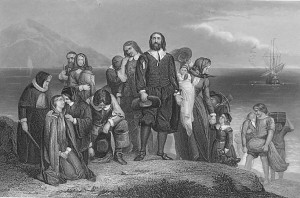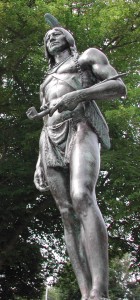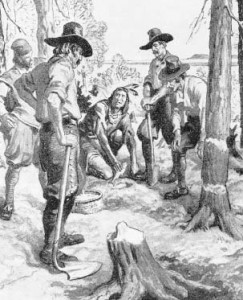One aspect of Pilgrim history that everyone seems connected with is the harmony that existed between the settlers and the natives. Was that the case, or is this another legend that has become supposed fact? Let me provide the best analysis I can on this question.
 Upon arrival, as I mentioned in an earlier post, the Pilgrims made a big mistake by taking some buried corn from one tribe. They did so out of their need, and they comforted themselves by promising to themselves that they would repay it someday. Their action was observed, and this caused friction right away with this tribe. Although the Pilgrims didn’t eventually settle where this tribe lived, the natives harbored animosity over what they rightly considered theft of their property. Later, the Pilgrims did indeed restore what they had taken, but it would have been far better to avoid this initial controversy.
Upon arrival, as I mentioned in an earlier post, the Pilgrims made a big mistake by taking some buried corn from one tribe. They did so out of their need, and they comforted themselves by promising to themselves that they would repay it someday. Their action was observed, and this caused friction right away with this tribe. Although the Pilgrims didn’t eventually settle where this tribe lived, the natives harbored animosity over what they rightly considered theft of their property. Later, the Pilgrims did indeed restore what they had taken, but it would have been far better to avoid this initial controversy.
The land on which they finally decided to establish their colony was uninhabited, so they didn’t take land away from any tribe by settling there. What they didn’t know was that a massive plague had swept through this entire region a few years earlier, wiping out the tribe that had lived on this particular spot. As a result, no other tribe claimed this land, fearing it was cursed.
Why the plague? What caused it? It could have been the result of the spread of a disease that the natives contracted through contact with passing Europeans. We don’t know for sure. Yet those with a chip on their shoulders today like to point to incidents such as these as some type of genocide on the part of Europeans. While the effects may have decimated the native population, this was hardly a planned genocide. The interactions of two peoples who have not had any contact with each other—and therefore no immunities built up against certain diseases—has often ended with new sicknesses spreading among one or both populations. There certainly wasn’t anything intentional about it.
Whatever the cause, the tribe that used to live on this piece of land was known for its hostility to European explorers’ ships previously. If the Pilgrims had settled anywhere near this tribe, weakened as they were their first winter in the New World, they might have been overcome and wiped out by that tribe. That would have been intentional genocide. Whether providential or not, the absence of this tribe allowed the Pilgrims to survive that first winter.
 The closest tribe to them, the Wampanoags, had been the strongest tribe in the region until the plague severely cut down its numbers. The chief, Massasoit, was looking for allies. Here’s another fact that often is ignored: the various tribes were not innocent primitives living in total harmony with the land and each other. They were sinful human beings who often preyed upon and made war against one another. Massasoit, keenly aware of his vulnerability, sought to unite with as many other tribes as possible. These new settlers were simply one more tribe, in his view.
The closest tribe to them, the Wampanoags, had been the strongest tribe in the region until the plague severely cut down its numbers. The chief, Massasoit, was looking for allies. Here’s another fact that often is ignored: the various tribes were not innocent primitives living in total harmony with the land and each other. They were sinful human beings who often preyed upon and made war against one another. Massasoit, keenly aware of his vulnerability, sought to unite with as many other tribes as possible. These new settlers were simply one more tribe, in his view.
During the Pilgrims’ first winter, Massasoit sent spies to watch how they were doing. In the spring, he sent one particular man, Samoset, to enter their settlement and speak to them. Samoset was a warrior who had spent time on European ships and had learned some English. This was the first real contact, and it was friendly. Once Samoset reported back, Massasoit decided to go himself and see if this new “tribe” might be useful to him
The result was a treaty mutually agreed upon that lasted more than fifty years. At one point, a few years later, when it seemed as if Massasoit might die from some unknown ailment, Edward Winslow went to his camp and treated him successfully, so that he survived. That cemented the relationship.
One name everyone has heard is Squanto, but most usually don’t know the whole story. Squanto was from the tribe that was wiped out by the plague, but he was spared because he had been kidnapped by a passing ship and sold into slavery in Spain. He eventually made his way to England, lived there a while, and learned English well. A couple of years later, he was able to return to his native land, only to find nearly everyone he knew had died. Squanto was living with the Wamanoags, but since he was not of their tribe, Massasoit didn’t know whether to trust him.
 Yet because Squanto had such a command of the English language, he became the liaison between the cultures. He did help the English with some tips on how to plant and fish in his native region, and he and William Bradford became good friends. What most people don’t know, however, is that Squanto apparently had designs to supplant Massasoit as leader. He even told the Wampanoags that the Pilgrims had the plague kept in storage to use against anyone who came against them, and that he alone was their protector to ensure it was not unleashed.
Yet because Squanto had such a command of the English language, he became the liaison between the cultures. He did help the English with some tips on how to plant and fish in his native region, and he and William Bradford became good friends. What most people don’t know, however, is that Squanto apparently had designs to supplant Massasoit as leader. He even told the Wampanoags that the Pilgrims had the plague kept in storage to use against anyone who came against them, and that he alone was their protector to ensure it was not unleashed.
At one point, Massasoit demanded Bradford turn Squanto over to him for execution, but Bradford refused, nearly rupturing the relationship with Massasoit. Squanto, however, died only about a year after the Pilgrims’ arrival. Some think he was poisoned by Massasoit. As he was dying, he asked the Pilgrims to pray that he would go to the English God. Does that mean Squanto became a true Christian, or was he merely hedging his bets at the end? No one can say for sure.
For the rest of Bradford’s life, Massasoit remained an ally. When the first generation, on both sides, left the historical scene, relations soured. But that’s another story for another time.
So what’s the verdict? From all the evidence, I believe we can honestly say that the Pilgrims and their closest neighbors did establish a mutual treaty of cooperation that worked well. Compared to Jamestown, this was a rousing success.
One more thing: about that first Thanksgiving? Yes, it actually happened, and it was a time of “bonding,” shall we say, of these two cultures.

